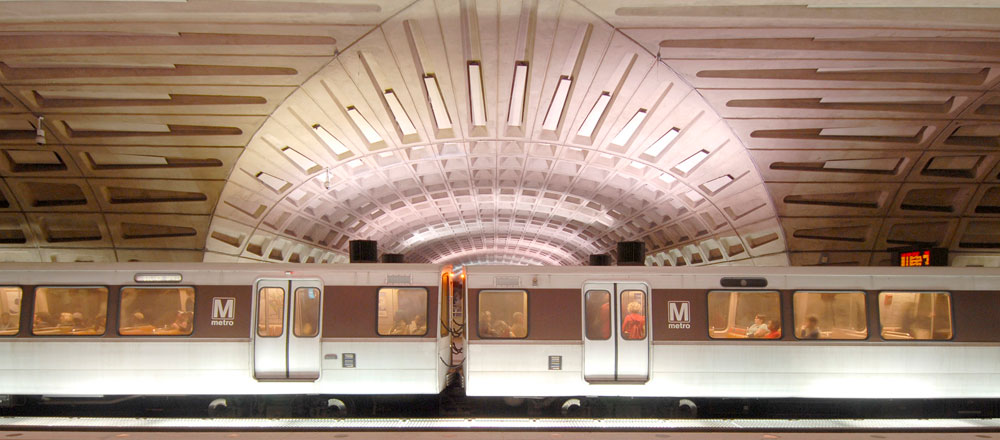Twenty-Five Year Award for Metro in Washington, D.C.

Each day, nearly a million people experience the architecture in the Washington, D.C. Metro, either in stations Haary Weese designed or ones derived from his common design kit-of-parts. This makes the metro, which opened in 1976, second only to New York City’s subway in daily ridership. The AIA recognized an architectural design of enduring significance.
Station-to-station, line-to-line, its unity and coherence is immutable. Across 86 stations (underground, at-grade, and elevated) spread over five lines that cover 106 miles, the design identity of each station shines through. If one’s commute begins at a ground-level suburban fringe station next to a parking lot and ends at a hub of crisscrossing train tracks deep below downtown D.C., the common design elements and shared materials make each space navigable and understandable. Colossal concrete vaults, granite and bronze are put together in an unmistakably monumental, Mid-Century Modern manner. These design elements, created by Weese over 40 years ago, still define Metro, as its newest stations on the Silver Line march further into the Virginia suburbs, set to open later in 2014.
From 1960 to 1970, the population of the Washington, D.C. metropolitan region exploded, adding nearly a million people, even as the population of the District of Columbia shrank. Metro would better connect the city and suburbs, and make urban living more convenient and vibrant. Implicitly, there was the hope that investing in Metro would save the suffering mid-century city as a typology, giving the nation a successful case study of how transit can help turn around urbanism in decline.
“The Metro changed Washington, D.C., from a sleepy Southern town into a world-class capital city,” said Jack Hartray, who worked for Weese on Metro. From the outset, Weese and Metro knew exactly what they did not want: the New York City subway. Metro was defined totally in opposition to the most successful urban rail transit system in North America. Instead, Metro would be airy, spacious, and ennobling. It would accomplish this through size and scale. As Harry Weese explained in The Great Society Subway, “Our whole thrust is to maximize the volume.” It would use the formal language of monumental civic architecture, seen so often in Washington’s federal buildings, and watch it seep into the earth, below ground, for the yeoman’s task of public transit.
Washington’s recent ascendance, beyond being the national political capital, into an emerging cultural and artistic creative class destination probably couldn’t have happened without Metro. It’s radically reshaped D.C., enabling the redevelopment of long-suffering neighborhoods into magnets for the young, highly educated and affluent knowledge economy workers that drive its booming economy.
Washington’s recent ascendance, beyond being the national political capital, into an emerging cultural and artistic creative class destination probably couldn’t have happened without Metro. It’s radically reshaped D.C., enabling the redevelopment of long-suffering neighborhoods into magnets for the young, highly educated and affluent knowledge economy workers that drive its booming economy.
The Twenty-five Year Award is conferred on a structure that has stood the test of time by embodying architectural excellence for 25 to 35 years. Projects must demonstrate excellence in function, in the distinguished execution of its original program, and in the creative aspects of its statement by today’s standards. The award will be presented this June at the AIA National Convention in Chicago, the home of its architect, Harry Weese, who died in 1998.
